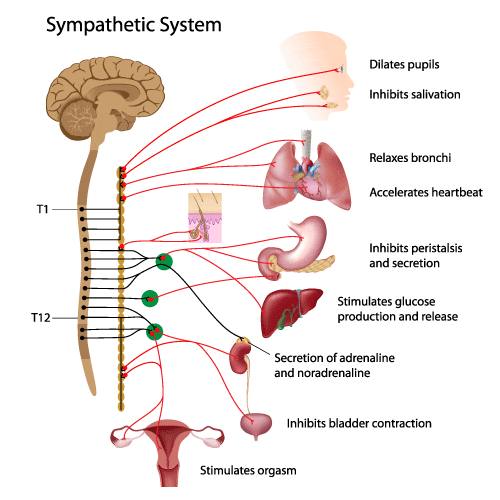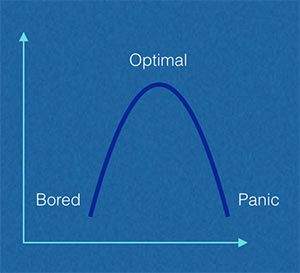
By Carl Valle
Everyone has heard of the “fight or flight” response when we are under stress, or in some cases danger. The physiological response of stress is a natural and important part of training, as stress from training, be in muscular or chemical is part of the process of improving. One needs to stress the body in order to adapt to it to the point the body is better. Yet in sport often we see athletes tighten up or failing to “wake up” at big moments in sport. I have added the third reaction freeze to the mix as many athletes become slow or fail to move at all. In this article we will explore more than just how the fight or flight system works in general, but how to properly use arousal in sport performance, specifically speed and power.

Figure 1: Sympathetic Nervous System
The sympathetic nervous system, the part of our body that helps athletes perform, is a popular topic now with training elite athletes. In this article the sympathetic nervous system (SNS) will be investigated, along with other internal systems of the body to show how powerful or bodies are in creating speed and power.
Butterflies in the Stomach?

Figure 2: The classic chart of being optimally aroused is very abstract and far from perfect, but it’s a good starting place to understand how being physiologically aroused needs to be the right level to be effective in performance.
We have all experienced near danger and felt the racing of our hearts when driving or other similar times of risk. That pounding in your chest isn’t from working hard in training but from the sudden surge of adrenaline, an important chemical in the body that helps prepare us for something in life that requires our uttermost performance. Sport, while entertaining and recreational, creates a stressful environment when major goals in life are hinged in a fleeting moment of time, creating a massive rise in adrenaline in the body. If prepared, athletes can actually take advantage of this physiological response and perform at higher levels. It’s OK to be be a little nervous but the key is making sure we are use to being aroused in training just a little bit by the right ways to induce intensity to training. My own coach use to say it’s OK to have butterflies in your stomach, so long as they were flying in formation! What what one needs to take away is that what may help many is not as simply as saying the bigger the anxiety the bigger the performance, because if it was just about getting more excited then all athletes would perform the same. Each athlete is unique and will respond differently, but in general the bigger the stage the bigger the response.
In the Zone? What is the flow experience really?
Many great athletes have had amazing performances in games that are meaningless and some have had amazing performances in the biggest game of their lives. When everything is statistically going right, many experts believe they are in the zone, or a flow experience where the athlete is entranced while playing. While skilled athletes may look effortless while playing, they are still highly aroused and they are explosive as well as being relaxed. The best athletes have the wonderful ability to not only be relaxed and coordinated, but be able to demonstrate explosive abilities at the same time. When one is in the zone, and optimal arousal exists that ensures the athlete is alert, relaxed, focused, and explosive. What the take home message is just being psyched up by listening to loud music isn’t going to do everything, and one needs to know how to channel that energy to something skilled and intelligent in games as well as training. While many sports psychologists will debate on what mental preparation skills will improve the chances of getting in the zone, the classic adage is that the mental maxes out the physical, meaning one is not likely to be a great athlete by just listening to self talk audio files on their iPod. You need to have both great training and great mental aptitude to perform at your highest level.
Testing—A dress rehearsal on making the nerves work for you
One is going to have various degrees of arousal based on experience and level of performance to different environments. An athlete may simply not be motivated to perform at their best when a preseason game is presented to them or maybe they rise to the occasion when it counts to most, like many veterans tend to do in various sports. The reality is many athletes will have some pride that will place them in a arousal level more in testing than when they are just doing something less objective. Anytime comparison occurs most athletes will want to compete against others or themselves. Soon as something has a winner or looser, or when something has a measurable outcome, athletes will raise their game. Quantification of anything, be it lifting a weight, running or jumping, and sometimes arbitrary tests will get athletes exited, especially if the test has value in predicting performance. While tests are measures of ability, they are also workouts as they are nothing more than training sessions with specific value and representation of abilities. Testing is training and training is testing as Vern Gambetta has shared for years. Not only does getting the data help understand how the training is going with development of athletes, the act of just testing increases the output of the workout, and any legal way of increasing performance is a holy grail to coaches. Testing isn’t going to be magically helping athletes win medals, but timing is a great way to improve any test that requires performance of speed, be it a short 5 m dash or a conditioning test that takes minutes.
Pump up the Volume—Five levels of arousal in training and competition with speed
Arousal is not just an off or on switch, but more like a dimmer knob with athletes. Also, as athletes become more and more adapted to speed and power training, the voltage or output of athletes increases as well. Coaches have known how to interpret the different levels and are known to know when to push and when to let athletes settle down a bit. Here are the five primary levels of arousal.

Figure 3: Arousal Classifications
As one can see practices will never have the outputs that games and competition have, but coaches start raising the output when the start testing more. Of course any stimulus will eventually loose it’s effect so the act of timing should not always have the act of testing environment. Coaches can time but not imply performance demands, especially when one is looking for recovery benefits and areas that are designed for active rest or restoration. Timing doesn’t need to be just about increasing performance by “maxing out” an athlete, it can be just finding the right level of arousal for the day.
Adjust the Bass—How to Tweak the levels of Arousal
After coaches and athletes understand arousal levels, one must decide to fine tune the level they are in to match the precise needs of the practice. In training, a workout can range from easy day in a pool loosening to the most demanding practice of one’s life, so a lot of flexibly and range exists when prescribing levels of intensity. At the end of the day a practice is still a practice, so coaches will have to manipulate other valuables, most just entity to elicit the improvements they want from training. Regardless to what one uses, several “tweaks can be done” when adding timing to the session. When one is using precision timing, a fresh set of options to fine tune just the right amount of output for athletes based on a wide variety of options.

Figure 4: Examples of Changes in Arousal
Two simple concepts to think about when collecting times is interpreting the context of the circumstances of the times collected. Athletes should be compared to themselves obviously, but each time can be evaluated with a fine tooth comb since so many factors can influence the results of the data collected. While some times will be subject to scrutiny, all coaches can do is record necessary details with a simple checklist or quick note while writing down or exporting the times from the watch. Another important consideration is how is the athlete improving overall with all of the factors involved? The reason we collect the times is to get a foundation of objective information, and it’s up to the coach and athlete to communicate and collaborate in ways to get the body faster after all of the contributing variables are analyzed and filtered.
Objective Review and Analysis
Coaches will range from timing once a year in the preseason to every workout, and this will mean interpretation will range in how much one can get from the information. If a team tests once a year, but always the second week of October, the coach can see if the athlete is coming into the season better prepared than the previous year. If they do all the right work and the program is similar, they have a good chance they will finish better as well. Coaches who time more will get more information as more practices splits will see how specific elements or phases in training will create changes in speed and power. Remember improvement is likely to be very small, say 1-2% with many advanced athletes, if at all. For example an athlete going from 4.41 to 4.32 in the 40 yard dash in one year is a massive improvement, since the beginning time and near the genetic ceiling of many athletes. With a 2% improvement over one year that means if one is improving linearly for ten months for the sake of easy math, the athlete is improving 0.2 percent a month, or 0.05 percent a practice. Such as small measure is not going to be seen day to day by anyone’s eye, but what can be seen is the ranges of time and averages in performance. One may not improve at all in practice absolutely, meaning they may not pop a all time best in practice, but if all of the sprints are improving on average, it’s likely that all of the training cumulatively is the reason for the ultimate performance down the road. Timing consistently allows coaches to see the value of consistency and improvement longitudinally instead of trying to have that one super workout be magical.
In summary, getting times is a valuable way to see patterns in development and cause and effect relationships with performance. The simple act of timing will create a measurable increase in output of used diligently in training, so powerful one can be susceptible to over-training if not used properly. Coaches need to know when to push, when to hold back, and when to let the session play itself out. Over time coaches will not only know more about their athletes, but more about their own workouts and how they relate to making changes to speed.
Please share this article so others may benefit.
[mashshare]
